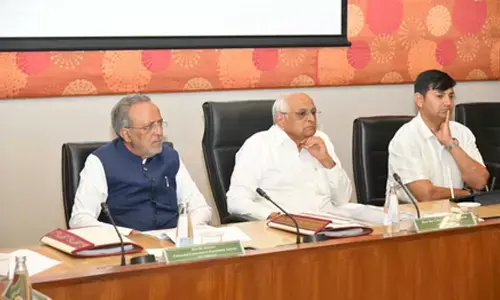
For Telangana protagonists, it has been a trend for decades to link all of Telangana’s woes to people from Andhra region. It must be remembered that Telangana and Seemandhra regions were under different regimes for 200 years, and that played a significant role in the diversity between the two regions.
Relevant 18th Century History: As a result of different agreements between the Nizam and the British, the British gained control over Northern Circars (present day Coastal Andhra) except Guntur in the year 1766, and Guntur in 1788. Rayalaseema was ‘ceded’ to the British by Nizam in the year 1800. The area was referred to as ‘Ceded Districts’. Northern Circars and Ceded Districts were part of Madras Presidency (see map) and were governed by the British until Indian Independence in 1947. The Princely State of Hyderabad which included Telangana region continued to be ruled by the Nizams until it was integrated into India after an Indian military/police action - Operation Polo in 1948.
Nizam Rule Over Telangana (1724–1948): Telangana, as part of Hyderabad State, was ruled by Nizams for more than 200 years. The Nizams were great builders and built many palaces. The present day AP Legislative Assembly, High Court, Osmania Arts College, Osmania Medical College, Jubilee Hall, Asafia Library are housed in buildings constructed by the Nizams. They developed railways, bus services, airport, postal service and radio service. In addition, six industrial units were established in Hyderabad State.
But unfortunately Hindus, who constituted more than 85% of the population, were ill-treated. As per 1941 census, less than 25% of officers in Civil Service were Hindus. Officials drawing a pay between Rs 600 and Rs1200 per month, only about 5% were Hindus. Regular police and Razakars (paramilitary force formed predominantly by Muslim volunteers) terrorized people. Temples were either destroyed or services in them denied. In the villages, Hindu Deshmukhs and Jagirdars, referred to as “Doras”, who formed the support base of the Nizams, ill-treated people, collected hefty land revenues and forced people to work without pay (“vetti”). Law enforcement and judicial systems were medieval and feudalistic and education system was outdated.
The Nizam and nobles owned 40% of the total land in the Kingdom. The ‘Time’ magazine dated February 22, 1937 had the portrait of last Nizam, Asaf Jah VII on its cover describing him as the world’s richest man. The Nizams not only had to extract taxes from people for their extraordinarily luxurious lifestyle but also for the huge money the Nizams had to pay to the British to prevent them from occupying the Nizams territory and mines. Persian was the official language up to 1893 and then Urdu up to 1948. Telugu language and culture were totally suppressed.
British icons who boosted Andhra economy and Telugu language:
During the same period, Andhra and Rayalaseema regions were ruled by the British. Compared to the Nizam rule, law enforcement, judicial system and education methods were ‘relatively’ more modern. The system of ‘Local Self Government’ was introduced by the British in the year 1885 where as a ‘request’ for a similar system was made to the Nizam by the people of Hyderabad state only in the year 1935. In addition, deeds of two Englishmen raised the standard of living of the common man and preserved the Telugu language.
Sir Arthur Cotton (1803 –1899): This “Apara Bhageeratha’s” works included Dowleswaram Barrage over Godavari, barrage over Krishna River and the Godavari Canal system which transformed drought and flood ravaged Godavari and Krishna districts into rice bowls of Andhra Pradesh. A whopping 30 lakh acres benefited from the canal systems developed by Sir Cotton.

Charles Philip Brown (1798 – 1884): “Andhra Bhashodhadara” – saviour of Telugu language. This Indian Civil services bureaucrat wrote several books in Telugu including the still acclaimed Brown (Telugu–English) dictionary. He spent his own money to get many Telugu works printed and was instrumental in the recovery and discovery of many old Telugu works. Today, the Oriental Library at Chennai stores many of his works. His selfless service to Telugu culture and literature is unparalleled even among Telugus. Another Englishman who needs mention here is Lord Curzon (1859-1925), Viceroy of India from 1899 to 1905, who promulgated “The Ancient Monuments Preservation Act” in 1904.
Under the less repressive and more progressive rule of the British and with the construction of barrages across Godavari and Krishna, the common man in Andhra region had better opportunities to improve his economic status than his counterpart in Telangana region. But after merger of the two regions in 1956, rates of growth for majority of development parameters were better for Telangana region. This has been confirmed by Srikrishna Committee. It is therefore, high time that Telangana protagonists stop cribbing about the alleged atrocities by their brothers (as they are now calling us) from Andhra region.
(The writer is a doctor, Vani Nursing Home, Narasapur, West Godavari District. The above article is an extract from the article "Telangana – Forays into History and Current Opinion" he submitted to Srikrishna Committee in March 2010)
It is a people’s movement

 For Telangana protagonists, it has been a trend for decades to link all of Telangana’s woes to people from Andhra region. It must be remembered that Telangana and Seemandhra regions were under different regimes for 200 years, and that played a significant role in the diversity between the two regions.
For Telangana protagonists, it has been a trend for decades to link all of Telangana’s woes to people from Andhra region. It must be remembered that Telangana and Seemandhra regions were under different regimes for 200 years, and that played a significant role in the diversity between the two regions. Charles Philip Brown (1798 – 1884): “Andhra Bhashodhadara” – saviour of Telugu language. This Indian Civil services bureaucrat wrote several books in Telugu including the still acclaimed Brown (Telugu–English) dictionary. He spent his own money to get many Telugu works printed and was instrumental in the recovery and discovery of many old Telugu works. Today, the Oriental Library at Chennai stores many of his works. His selfless service to Telugu culture and literature is unparalleled even among Telugus. Another Englishman who needs mention here is Lord Curzon (1859-1925), Viceroy of India from 1899 to 1905, who promulgated “The Ancient Monuments Preservation Act” in 1904.
Charles Philip Brown (1798 – 1884): “Andhra Bhashodhadara” – saviour of Telugu language. This Indian Civil services bureaucrat wrote several books in Telugu including the still acclaimed Brown (Telugu–English) dictionary. He spent his own money to get many Telugu works printed and was instrumental in the recovery and discovery of many old Telugu works. Today, the Oriental Library at Chennai stores many of his works. His selfless service to Telugu culture and literature is unparalleled even among Telugus. Another Englishman who needs mention here is Lord Curzon (1859-1925), Viceroy of India from 1899 to 1905, who promulgated “The Ancient Monuments Preservation Act” in 1904. The demand for Telangana is a people’s movement born out of their frustrations. It is not new; the people in the Telangana region had clearly expressed their opposition to merger a decade before Andhra Pradesh was formed. They had reasoned that in a united Andhra Pradesh they woul not get justice.
The demand for Telangana is a people’s movement born out of their frustrations. It is not new; the people in the Telangana region had clearly expressed their opposition to merger a decade before Andhra Pradesh was formed. They had reasoned that in a united Andhra Pradesh they woul not get justice.













